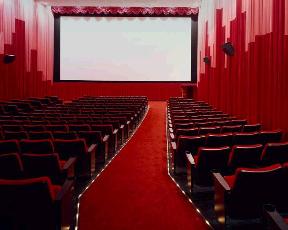Screenvision and National CineMedia Announce Interactive In-Theater Innovations

Originally published on April 16, 2008
At this week's Traffic Audit Bureau Conference in Boca Raton, the out-of-home industry embraced digital advances as a catalyst for maintaining the industry's status as the fastest growing segment of the traditional media marketplace (excluding online). Tim Hanlon, EVP Futures for Publicis Groupe's Denuo, called for media and creative advertising agencies to break-down their organizational silos and focus more aggressively on innovative opportunities within all media, and especially out-of-home. Hanlon criticized agencies for "waiting until large players like NBC and CBS introduce their 'NBC Everywhere' and 'CBS Outernet' initiatives to pay attention to digital out-of-home."
In the out-of-home category, media options that are highly targeted and have long dwell time have the greatest growth potential, said Zoom Media's Dennis Roche, and mobile is enabling interactive audience feedback options to both digital and traditional out-of-home, pointed out Kinetic Mobile president Michael Collins.
With the money spent to advertise on movie screens and in-theater growing 15 to 18 percent annually, cinema advertising companies are using mobile and other innovations to capture a growing share of market. Screenvision expects this month to announce a proprietary text-messaging system and subsequently announce an interactive in-theater gaming platform, JackMyers Media Business Report has learned.National CineMedia (NCM), with partner Brand Experience, is testing a technology that allows a movie audience to interact with ads on screen.
Mike Chico, Screenvision's EVP of Sales and Marketing says the new text-messaging system is a proprietary platform, involving a telecommunications partner. "We are gong to be rolling that out over the next several months," he says. "I can't say too much but it involves cellphones, text messaging and the ability to interact with our consumers."
The NCM/Brand Experience technology has been tested for Volvo in London, where audiences raised their arms and leaned left or right in front of hidden cameras to "steer" a car around in competition with other theater audiences. In Los Angeles, the audience played a virtual bouncing ball to eliminate news headlines from MSNBCin an arcade-like game. Video taken of the audiences showed them moving in tandem and laughing. "How many places do 300 or 400 or 500 people congregate and act together like this and share an experience?" asks Cliff Marks, NCM's CMO and President of Sales. "We have an engaging relationship with our audience that's unlike any other medium, because there are no remote controls or refrigerators to distract them," says Marks. If further tests this summer prove the ads' effectiveness, the technology will be rolled out in the fall to 750 screens nationwide.
The Cinema Advertising Council said last year that its members increased ad revenues 15% to $455.7 million. JackMyers.com projects those revenues will grow 17.5% in 2008. A big part of the reason is the hundreds of millions dollars spent over the past five years to digitize theaters. That technology has enabled targeting ads to different locales depending on everything from climate, to proximity to a certain retailer, to likely audience composition while eliminating the need to ship thousands of reels that a projectionist must assemble. NCM and Screenvision feel they outdo TV by giving exact ticket sales numbers and by adjusting their rate cards according to what percentage of the audience is found by studies to be in the seats at given times before the previews start. Screenvision says it, unlike NCM, sells the pod just before the previews.
In previous generations, U.S. audiences may have recoiled at movie ads, but today's movie-goers are overwhelmingly accepting. JackMyers 2007 Emotional Connections™ research of 8,000 Americans found that pre-movie video ads ranked first among adults 18 to 24 in advertising attentiveness.Theaters have few of the distractions of home, but cinema advertisers are very sensitive about potentially turning off their captive, paying customers. Movie screen advertisers "go to special lengths to make sure the quality is engaging, unique, frequently of a humorous nature, and delivering content either completely or somewhat different from what they might run in other media," says CAC Chairman and President Stu Ballatt, who is also a Screenvision executive. Companies like NBC-Universal, Sony, A&E and Turner Broadcasting have all produced two to three minute segments, often with high-profile entertainers, that make up the 20 to 30 minute pre-show programs.
Together, NCM and Screenvision control about 32,000 of some 37,000 major theater screens in the United States. NCM, owned jointly by the Regal, AMC and Cinemark theater chains, leads in the number of screens and says it has the major "stadium" theaters. Screenvision has 2,400 theaters, about double NCM's number, and therefore claims more points of distribution. Loews' 1,700 screens, now owned by AMC, will soon shift to NCM from Screenvision, and both companies are planning to add more than a thousand new screens this year from other operators. However you count , says Mike Chico, Screenvision's EVP of Sales and Marketing, "it's a two-horse race." Competing theater chains are cooperating to achieve success by allowing ad buys across their networks. They're engaging audiences with fun ads while targeting carefully among sub-groups in a national audience. They're creating a fun environment beyond the screens to engage audiences further.
Both companies are experimenting with yet newer technologies. NCM is teaming with Reactrix to test interactive video ads on theater floors in six theaters in New York, Chicago, San Francisco, Los Angeles and Dallas. "We also control the lobbyspace, popcorn bags, the handouts. You name it, if it's in that theater," claimed Marks, "National CineMedia is the company that handles it. But we asked ourselves, is there a way to create more interaction with the customer? In the cinema, we can actually reach out and touch people." JackMyers Media Business Reporthas learned that a test conducted by Samsung in four U.S. shopping malls found the Reactrix ads to be highly effective in recall and brand favorability. The CAC this year will participate in an IMMI research study using specially equipped cell phones that will help measure participants' exposure to audio in ads.
As the national television Upfront market approaches, cinema advertising is being considered as an option by major network television media buyers, further spurring the industry's growth. "I won't go as far as to say there's a shift from broadcast dollars," Chico says, "but we are being considered in the Upfront by several agencies and that's exciting. It opens the doors to a different scope of media buyer and planner."
Stu Ballatt can be reached at SBallatt@Screenvision.com.
Cliff Marks can be reached at cliff.marks@ncm.com
Mike Chico can be reached at MChico@Screenvision.com.
Dorian Benkoil is a regular contributor to JackMyers Media Business Report.


